TECO401 Essay: Monopoly, Monopolistic Competition & Gov. Intervention
VerifiedAdded on 2023/06/04
|14
|2758
|188
Essay
AI Summary
This essay identifies examples of monopoly and monopolistic competition within Australian industries, focusing on the retail sector with Coles and Woolworths as examples of monopolies and pizza restaurants as examples of monopolistic competition. It explains how and why governments may engage in policy intervention with respect to monopolies through price capping, quality service regulation, merger policies, and breaking up monopolies, but generally do not intervene in monopolistically competitive markets. The essay discusses the benefits and costs of both market structures, highlighting the potential for consumer exploitation in monopolies and the product differentiation and market contestability in monopolistic competition. The analysis incorporates economic principles related to benefits, costs, and market structure to inform the decisions and support the arguments presented.
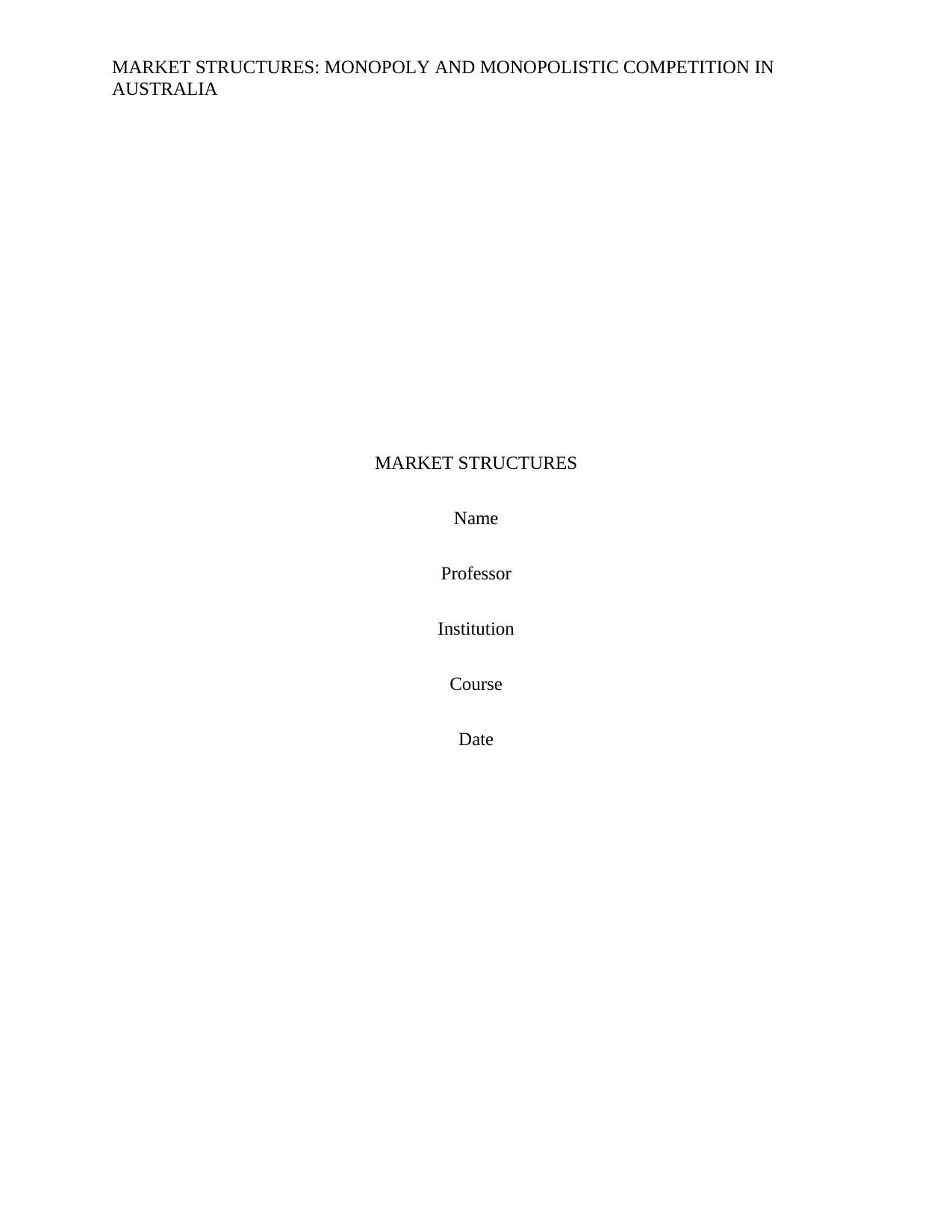
MARKET STRUCTURES: MONOPOLY AND MONOPOLISTIC COMPETITION IN
AUSTRALIA
MARKET STRUCTURES
Name
Professor
Institution
Course
Date
AUSTRALIA
MARKET STRUCTURES
Name
Professor
Institution
Course
Date
Paraphrase This Document
Need a fresh take? Get an instant paraphrase of this document with our AI Paraphraser
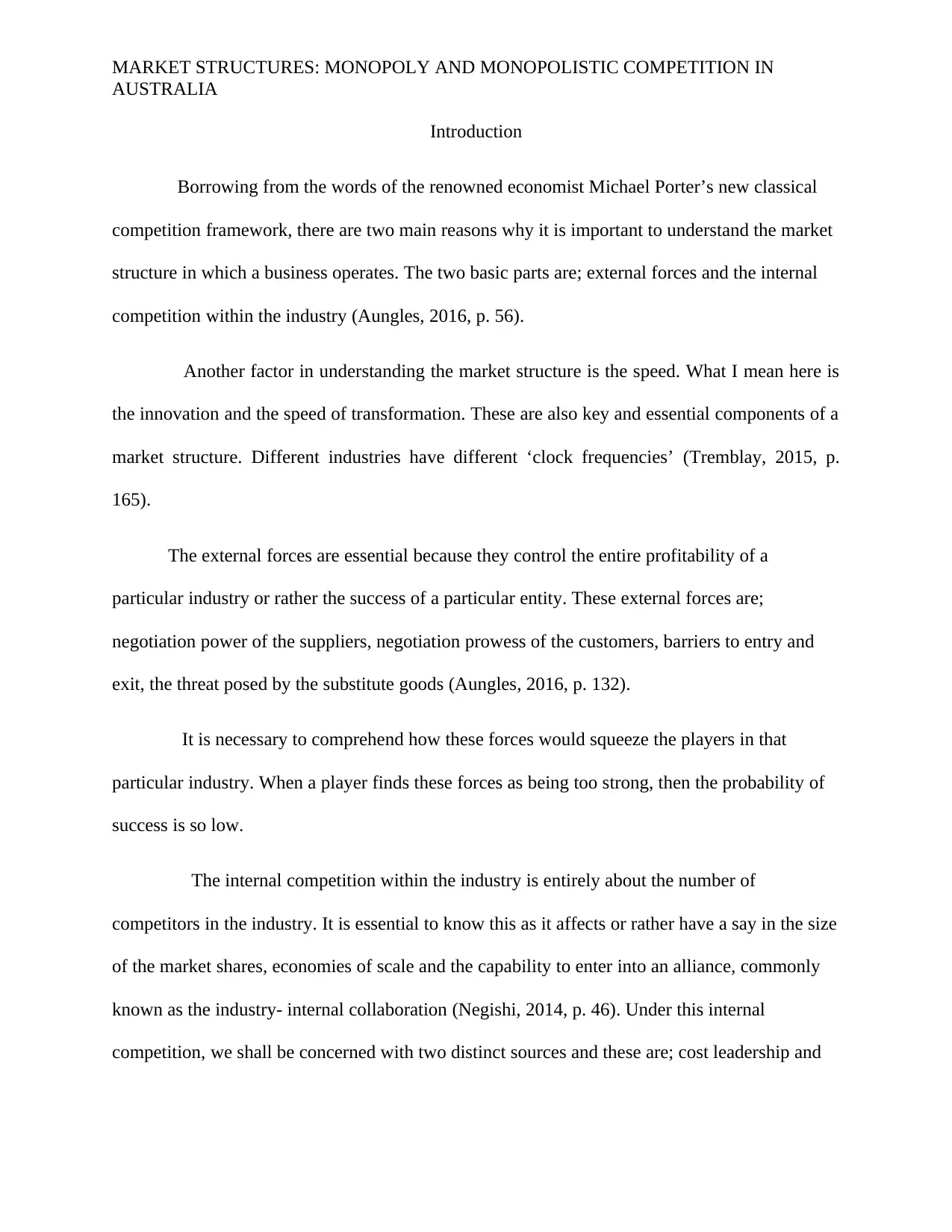
MARKET STRUCTURES: MONOPOLY AND MONOPOLISTIC COMPETITION IN
AUSTRALIA
Introduction
Borrowing from the words of the renowned economist Michael Porter’s new classical
competition framework, there are two main reasons why it is important to understand the market
structure in which a business operates. The two basic parts are; external forces and the internal
competition within the industry (Aungles, 2016, p. 56).
Another factor in understanding the market structure is the speed. What I mean here is
the innovation and the speed of transformation. These are also key and essential components of a
market structure. Different industries have different ‘clock frequencies’ (Tremblay, 2015, p.
165).
The external forces are essential because they control the entire profitability of a
particular industry or rather the success of a particular entity. These external forces are;
negotiation power of the suppliers, negotiation prowess of the customers, barriers to entry and
exit, the threat posed by the substitute goods (Aungles, 2016, p. 132).
It is necessary to comprehend how these forces would squeeze the players in that
particular industry. When a player finds these forces as being too strong, then the probability of
success is so low.
The internal competition within the industry is entirely about the number of
competitors in the industry. It is essential to know this as it affects or rather have a say in the size
of the market shares, economies of scale and the capability to enter into an alliance, commonly
known as the industry- internal collaboration (Negishi, 2014, p. 46). Under this internal
competition, we shall be concerned with two distinct sources and these are; cost leadership and
AUSTRALIA
Introduction
Borrowing from the words of the renowned economist Michael Porter’s new classical
competition framework, there are two main reasons why it is important to understand the market
structure in which a business operates. The two basic parts are; external forces and the internal
competition within the industry (Aungles, 2016, p. 56).
Another factor in understanding the market structure is the speed. What I mean here is
the innovation and the speed of transformation. These are also key and essential components of a
market structure. Different industries have different ‘clock frequencies’ (Tremblay, 2015, p.
165).
The external forces are essential because they control the entire profitability of a
particular industry or rather the success of a particular entity. These external forces are;
negotiation power of the suppliers, negotiation prowess of the customers, barriers to entry and
exit, the threat posed by the substitute goods (Aungles, 2016, p. 132).
It is necessary to comprehend how these forces would squeeze the players in that
particular industry. When a player finds these forces as being too strong, then the probability of
success is so low.
The internal competition within the industry is entirely about the number of
competitors in the industry. It is essential to know this as it affects or rather have a say in the size
of the market shares, economies of scale and the capability to enter into an alliance, commonly
known as the industry- internal collaboration (Negishi, 2014, p. 46). Under this internal
competition, we shall be concerned with two distinct sources and these are; cost leadership and
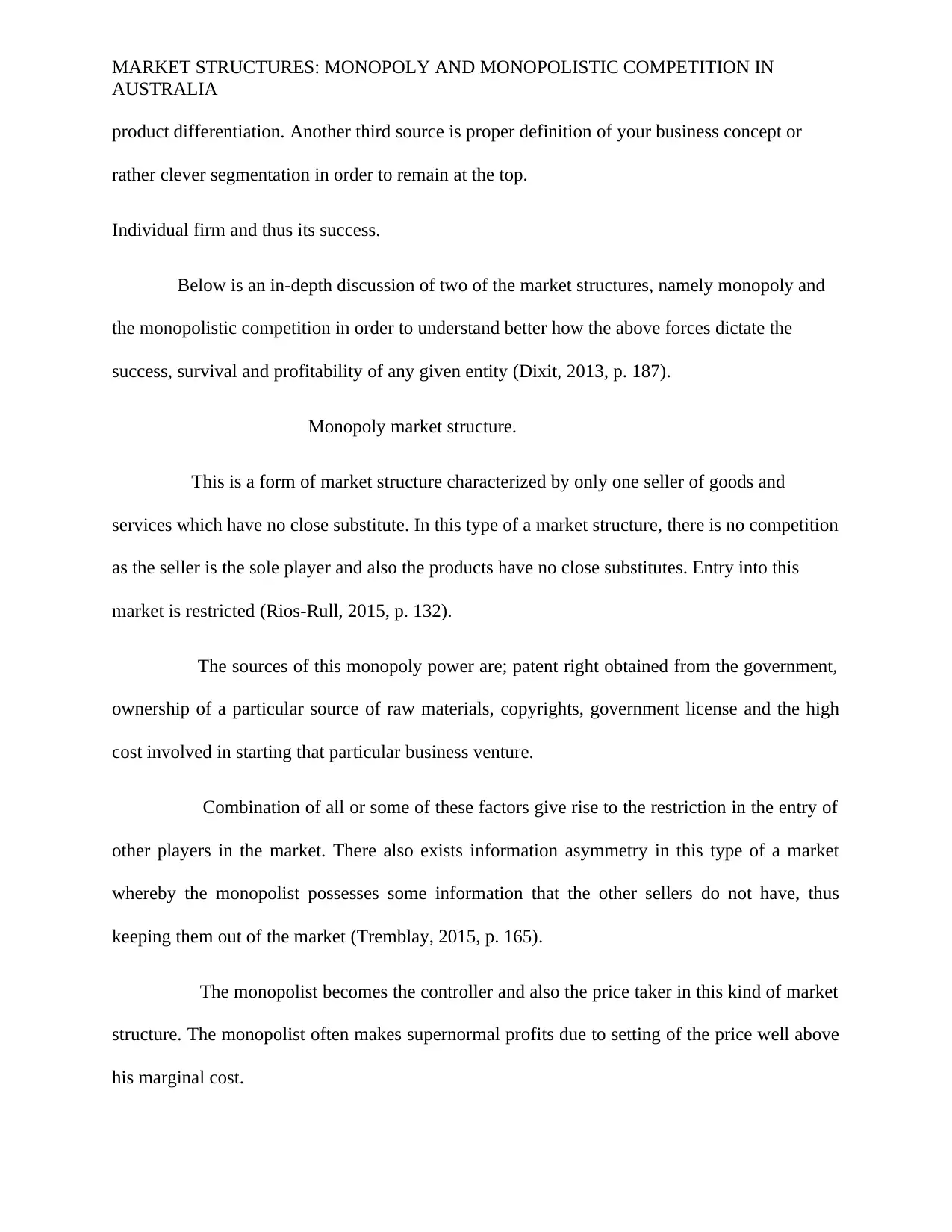
MARKET STRUCTURES: MONOPOLY AND MONOPOLISTIC COMPETITION IN
AUSTRALIA
product differentiation. Another third source is proper definition of your business concept or
rather clever segmentation in order to remain at the top.
Individual firm and thus its success.
Below is an in-depth discussion of two of the market structures, namely monopoly and
the monopolistic competition in order to understand better how the above forces dictate the
success, survival and profitability of any given entity (Dixit, 2013, p. 187).
Monopoly market structure.
This is a form of market structure characterized by only one seller of goods and
services which have no close substitute. In this type of a market structure, there is no competition
as the seller is the sole player and also the products have no close substitutes. Entry into this
market is restricted (Rios-Rull, 2015, p. 132).
The sources of this monopoly power are; patent right obtained from the government,
ownership of a particular source of raw materials, copyrights, government license and the high
cost involved in starting that particular business venture.
Combination of all or some of these factors give rise to the restriction in the entry of
other players in the market. There also exists information asymmetry in this type of a market
whereby the monopolist possesses some information that the other sellers do not have, thus
keeping them out of the market (Tremblay, 2015, p. 165).
The monopolist becomes the controller and also the price taker in this kind of market
structure. The monopolist often makes supernormal profits due to setting of the price well above
his marginal cost.
AUSTRALIA
product differentiation. Another third source is proper definition of your business concept or
rather clever segmentation in order to remain at the top.
Individual firm and thus its success.
Below is an in-depth discussion of two of the market structures, namely monopoly and
the monopolistic competition in order to understand better how the above forces dictate the
success, survival and profitability of any given entity (Dixit, 2013, p. 187).
Monopoly market structure.
This is a form of market structure characterized by only one seller of goods and
services which have no close substitute. In this type of a market structure, there is no competition
as the seller is the sole player and also the products have no close substitutes. Entry into this
market is restricted (Rios-Rull, 2015, p. 132).
The sources of this monopoly power are; patent right obtained from the government,
ownership of a particular source of raw materials, copyrights, government license and the high
cost involved in starting that particular business venture.
Combination of all or some of these factors give rise to the restriction in the entry of
other players in the market. There also exists information asymmetry in this type of a market
whereby the monopolist possesses some information that the other sellers do not have, thus
keeping them out of the market (Tremblay, 2015, p. 165).
The monopolist becomes the controller and also the price taker in this kind of market
structure. The monopolist often makes supernormal profits due to setting of the price well above
his marginal cost.
⊘ This is a preview!⊘
Do you want full access?
Subscribe today to unlock all pages.

Trusted by 1+ million students worldwide
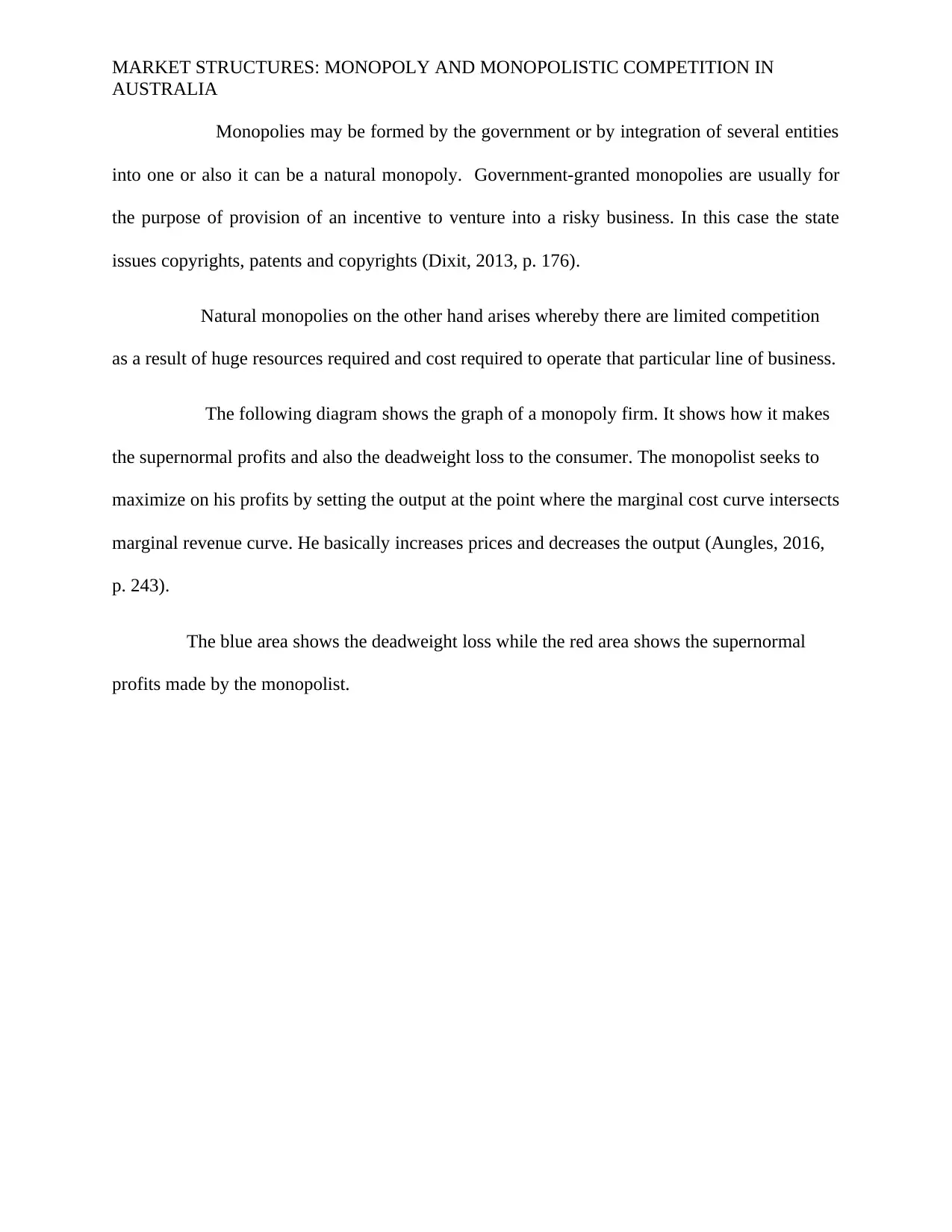
MARKET STRUCTURES: MONOPOLY AND MONOPOLISTIC COMPETITION IN
AUSTRALIA
Monopolies may be formed by the government or by integration of several entities
into one or also it can be a natural monopoly. Government-granted monopolies are usually for
the purpose of provision of an incentive to venture into a risky business. In this case the state
issues copyrights, patents and copyrights (Dixit, 2013, p. 176).
Natural monopolies on the other hand arises whereby there are limited competition
as a result of huge resources required and cost required to operate that particular line of business.
The following diagram shows the graph of a monopoly firm. It shows how it makes
the supernormal profits and also the deadweight loss to the consumer. The monopolist seeks to
maximize on his profits by setting the output at the point where the marginal cost curve intersects
marginal revenue curve. He basically increases prices and decreases the output (Aungles, 2016,
p. 243).
The blue area shows the deadweight loss while the red area shows the supernormal
profits made by the monopolist.
AUSTRALIA
Monopolies may be formed by the government or by integration of several entities
into one or also it can be a natural monopoly. Government-granted monopolies are usually for
the purpose of provision of an incentive to venture into a risky business. In this case the state
issues copyrights, patents and copyrights (Dixit, 2013, p. 176).
Natural monopolies on the other hand arises whereby there are limited competition
as a result of huge resources required and cost required to operate that particular line of business.
The following diagram shows the graph of a monopoly firm. It shows how it makes
the supernormal profits and also the deadweight loss to the consumer. The monopolist seeks to
maximize on his profits by setting the output at the point where the marginal cost curve intersects
marginal revenue curve. He basically increases prices and decreases the output (Aungles, 2016,
p. 243).
The blue area shows the deadweight loss while the red area shows the supernormal
profits made by the monopolist.
Paraphrase This Document
Need a fresh take? Get an instant paraphrase of this document with our AI Paraphraser
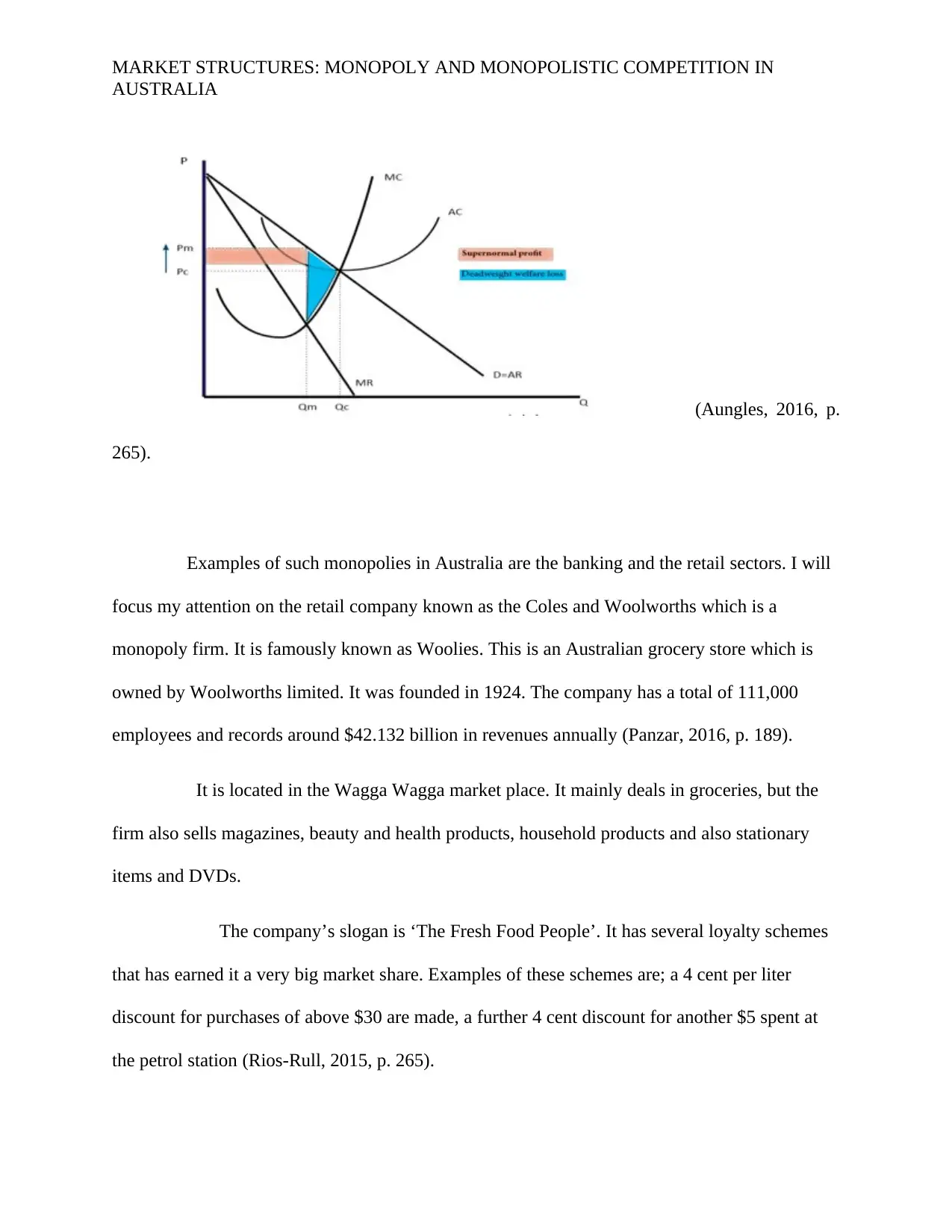
MARKET STRUCTURES: MONOPOLY AND MONOPOLISTIC COMPETITION IN
AUSTRALIA
(Aungles, 2016, p.
265).
Examples of such monopolies in Australia are the banking and the retail sectors. I will
focus my attention on the retail company known as the Coles and Woolworths which is a
monopoly firm. It is famously known as Woolies. This is an Australian grocery store which is
owned by Woolworths limited. It was founded in 1924. The company has a total of 111,000
employees and records around $42.132 billion in revenues annually (Panzar, 2016, p. 189).
It is located in the Wagga Wagga market place. It mainly deals in groceries, but the
firm also sells magazines, beauty and health products, household products and also stationary
items and DVDs.
The company’s slogan is ‘The Fresh Food People’. It has several loyalty schemes
that has earned it a very big market share. Examples of these schemes are; a 4 cent per liter
discount for purchases of above $30 are made, a further 4 cent discount for another $5 spent at
the petrol station (Rios-Rull, 2015, p. 265).
AUSTRALIA
(Aungles, 2016, p.
265).
Examples of such monopolies in Australia are the banking and the retail sectors. I will
focus my attention on the retail company known as the Coles and Woolworths which is a
monopoly firm. It is famously known as Woolies. This is an Australian grocery store which is
owned by Woolworths limited. It was founded in 1924. The company has a total of 111,000
employees and records around $42.132 billion in revenues annually (Panzar, 2016, p. 189).
It is located in the Wagga Wagga market place. It mainly deals in groceries, but the
firm also sells magazines, beauty and health products, household products and also stationary
items and DVDs.
The company’s slogan is ‘The Fresh Food People’. It has several loyalty schemes
that has earned it a very big market share. Examples of these schemes are; a 4 cent per liter
discount for purchases of above $30 are made, a further 4 cent discount for another $5 spent at
the petrol station (Rios-Rull, 2015, p. 265).
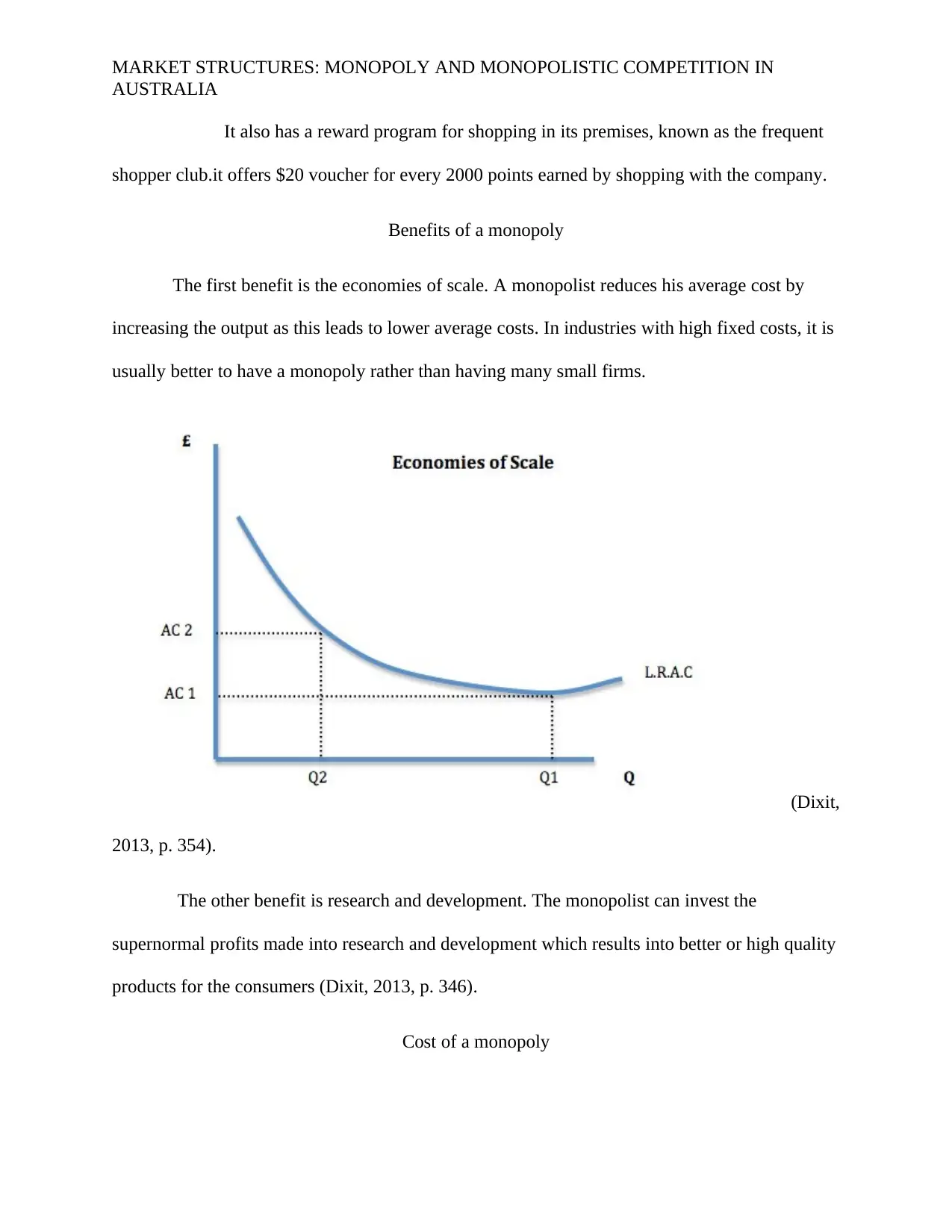
MARKET STRUCTURES: MONOPOLY AND MONOPOLISTIC COMPETITION IN
AUSTRALIA
It also has a reward program for shopping in its premises, known as the frequent
shopper club.it offers $20 voucher for every 2000 points earned by shopping with the company.
Benefits of a monopoly
The first benefit is the economies of scale. A monopolist reduces his average cost by
increasing the output as this leads to lower average costs. In industries with high fixed costs, it is
usually better to have a monopoly rather than having many small firms.
(Dixit,
2013, p. 354).
The other benefit is research and development. The monopolist can invest the
supernormal profits made into research and development which results into better or high quality
products for the consumers (Dixit, 2013, p. 346).
Cost of a monopoly
AUSTRALIA
It also has a reward program for shopping in its premises, known as the frequent
shopper club.it offers $20 voucher for every 2000 points earned by shopping with the company.
Benefits of a monopoly
The first benefit is the economies of scale. A monopolist reduces his average cost by
increasing the output as this leads to lower average costs. In industries with high fixed costs, it is
usually better to have a monopoly rather than having many small firms.
(Dixit,
2013, p. 354).
The other benefit is research and development. The monopolist can invest the
supernormal profits made into research and development which results into better or high quality
products for the consumers (Dixit, 2013, p. 346).
Cost of a monopoly
⊘ This is a preview!⊘
Do you want full access?
Subscribe today to unlock all pages.

Trusted by 1+ million students worldwide
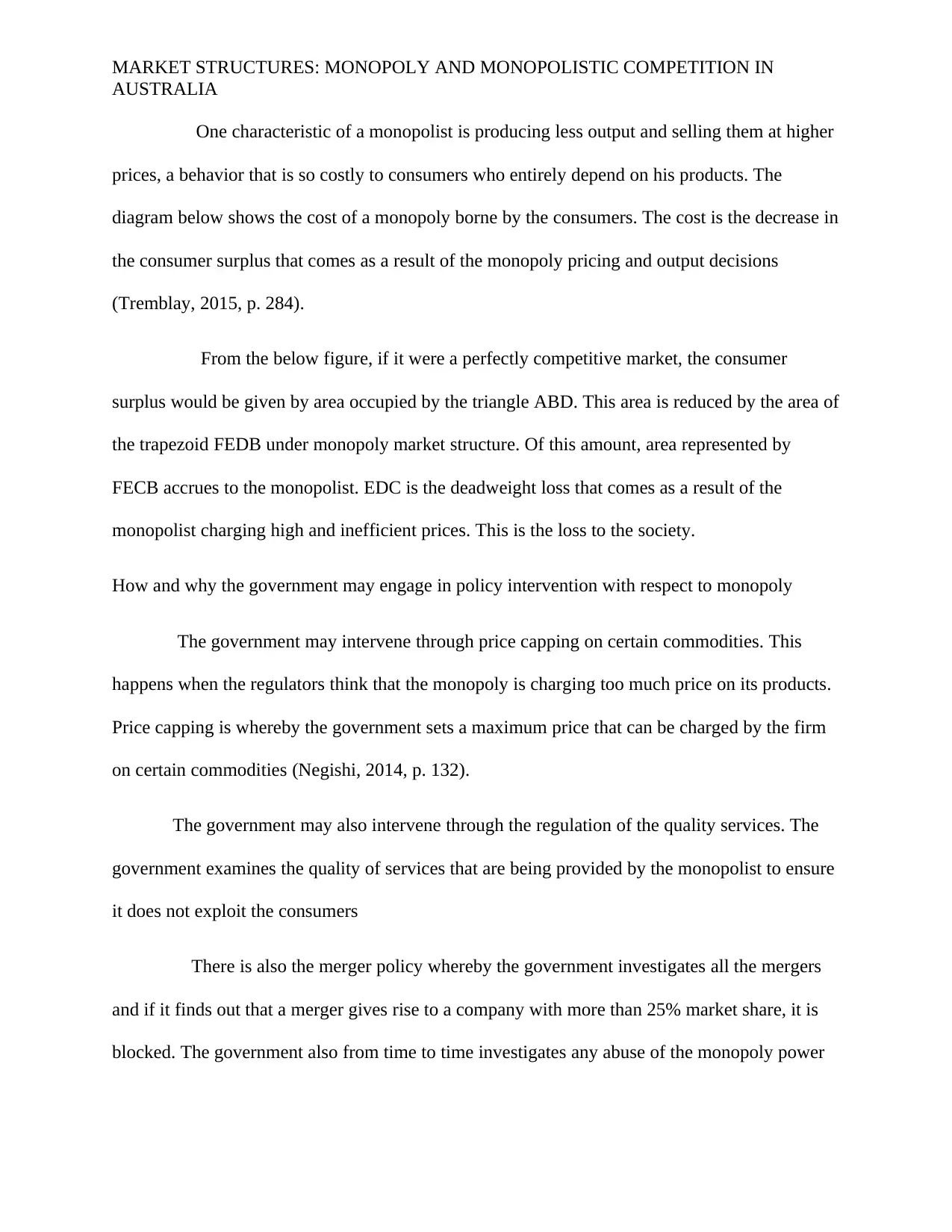
MARKET STRUCTURES: MONOPOLY AND MONOPOLISTIC COMPETITION IN
AUSTRALIA
One characteristic of a monopolist is producing less output and selling them at higher
prices, a behavior that is so costly to consumers who entirely depend on his products. The
diagram below shows the cost of a monopoly borne by the consumers. The cost is the decrease in
the consumer surplus that comes as a result of the monopoly pricing and output decisions
(Tremblay, 2015, p. 284).
From the below figure, if it were a perfectly competitive market, the consumer
surplus would be given by area occupied by the triangle ABD. This area is reduced by the area of
the trapezoid FEDB under monopoly market structure. Of this amount, area represented by
FECB accrues to the monopolist. EDC is the deadweight loss that comes as a result of the
monopolist charging high and inefficient prices. This is the loss to the society.
How and why the government may engage in policy intervention with respect to monopoly
The government may intervene through price capping on certain commodities. This
happens when the regulators think that the monopoly is charging too much price on its products.
Price capping is whereby the government sets a maximum price that can be charged by the firm
on certain commodities (Negishi, 2014, p. 132).
The government may also intervene through the regulation of the quality services. The
government examines the quality of services that are being provided by the monopolist to ensure
it does not exploit the consumers
There is also the merger policy whereby the government investigates all the mergers
and if it finds out that a merger gives rise to a company with more than 25% market share, it is
blocked. The government also from time to time investigates any abuse of the monopoly power
AUSTRALIA
One characteristic of a monopolist is producing less output and selling them at higher
prices, a behavior that is so costly to consumers who entirely depend on his products. The
diagram below shows the cost of a monopoly borne by the consumers. The cost is the decrease in
the consumer surplus that comes as a result of the monopoly pricing and output decisions
(Tremblay, 2015, p. 284).
From the below figure, if it were a perfectly competitive market, the consumer
surplus would be given by area occupied by the triangle ABD. This area is reduced by the area of
the trapezoid FEDB under monopoly market structure. Of this amount, area represented by
FECB accrues to the monopolist. EDC is the deadweight loss that comes as a result of the
monopolist charging high and inefficient prices. This is the loss to the society.
How and why the government may engage in policy intervention with respect to monopoly
The government may intervene through price capping on certain commodities. This
happens when the regulators think that the monopoly is charging too much price on its products.
Price capping is whereby the government sets a maximum price that can be charged by the firm
on certain commodities (Negishi, 2014, p. 132).
The government may also intervene through the regulation of the quality services. The
government examines the quality of services that are being provided by the monopolist to ensure
it does not exploit the consumers
There is also the merger policy whereby the government investigates all the mergers
and if it finds out that a merger gives rise to a company with more than 25% market share, it is
blocked. The government also from time to time investigates any abuse of the monopoly power
Paraphrase This Document
Need a fresh take? Get an instant paraphrase of this document with our AI Paraphraser
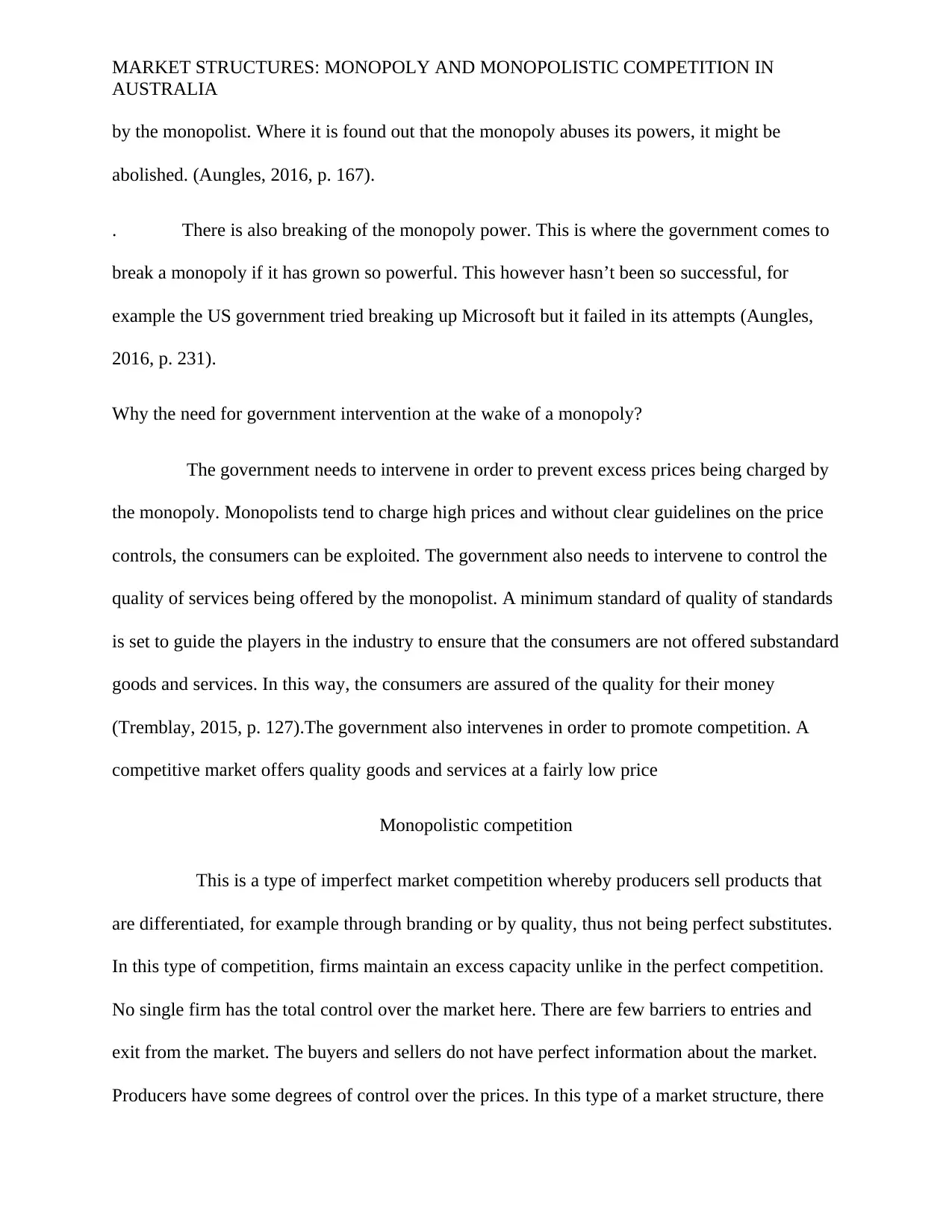
MARKET STRUCTURES: MONOPOLY AND MONOPOLISTIC COMPETITION IN
AUSTRALIA
by the monopolist. Where it is found out that the monopoly abuses its powers, it might be
abolished. (Aungles, 2016, p. 167).
. There is also breaking of the monopoly power. This is where the government comes to
break a monopoly if it has grown so powerful. This however hasn’t been so successful, for
example the US government tried breaking up Microsoft but it failed in its attempts (Aungles,
2016, p. 231).
Why the need for government intervention at the wake of a monopoly?
The government needs to intervene in order to prevent excess prices being charged by
the monopoly. Monopolists tend to charge high prices and without clear guidelines on the price
controls, the consumers can be exploited. The government also needs to intervene to control the
quality of services being offered by the monopolist. A minimum standard of quality of standards
is set to guide the players in the industry to ensure that the consumers are not offered substandard
goods and services. In this way, the consumers are assured of the quality for their money
(Tremblay, 2015, p. 127).The government also intervenes in order to promote competition. A
competitive market offers quality goods and services at a fairly low price
Monopolistic competition
This is a type of imperfect market competition whereby producers sell products that
are differentiated, for example through branding or by quality, thus not being perfect substitutes.
In this type of competition, firms maintain an excess capacity unlike in the perfect competition.
No single firm has the total control over the market here. There are few barriers to entries and
exit from the market. The buyers and sellers do not have perfect information about the market.
Producers have some degrees of control over the prices. In this type of a market structure, there
AUSTRALIA
by the monopolist. Where it is found out that the monopoly abuses its powers, it might be
abolished. (Aungles, 2016, p. 167).
. There is also breaking of the monopoly power. This is where the government comes to
break a monopoly if it has grown so powerful. This however hasn’t been so successful, for
example the US government tried breaking up Microsoft but it failed in its attempts (Aungles,
2016, p. 231).
Why the need for government intervention at the wake of a monopoly?
The government needs to intervene in order to prevent excess prices being charged by
the monopoly. Monopolists tend to charge high prices and without clear guidelines on the price
controls, the consumers can be exploited. The government also needs to intervene to control the
quality of services being offered by the monopolist. A minimum standard of quality of standards
is set to guide the players in the industry to ensure that the consumers are not offered substandard
goods and services. In this way, the consumers are assured of the quality for their money
(Tremblay, 2015, p. 127).The government also intervenes in order to promote competition. A
competitive market offers quality goods and services at a fairly low price
Monopolistic competition
This is a type of imperfect market competition whereby producers sell products that
are differentiated, for example through branding or by quality, thus not being perfect substitutes.
In this type of competition, firms maintain an excess capacity unlike in the perfect competition.
No single firm has the total control over the market here. There are few barriers to entries and
exit from the market. The buyers and sellers do not have perfect information about the market.
Producers have some degrees of control over the prices. In this type of a market structure, there
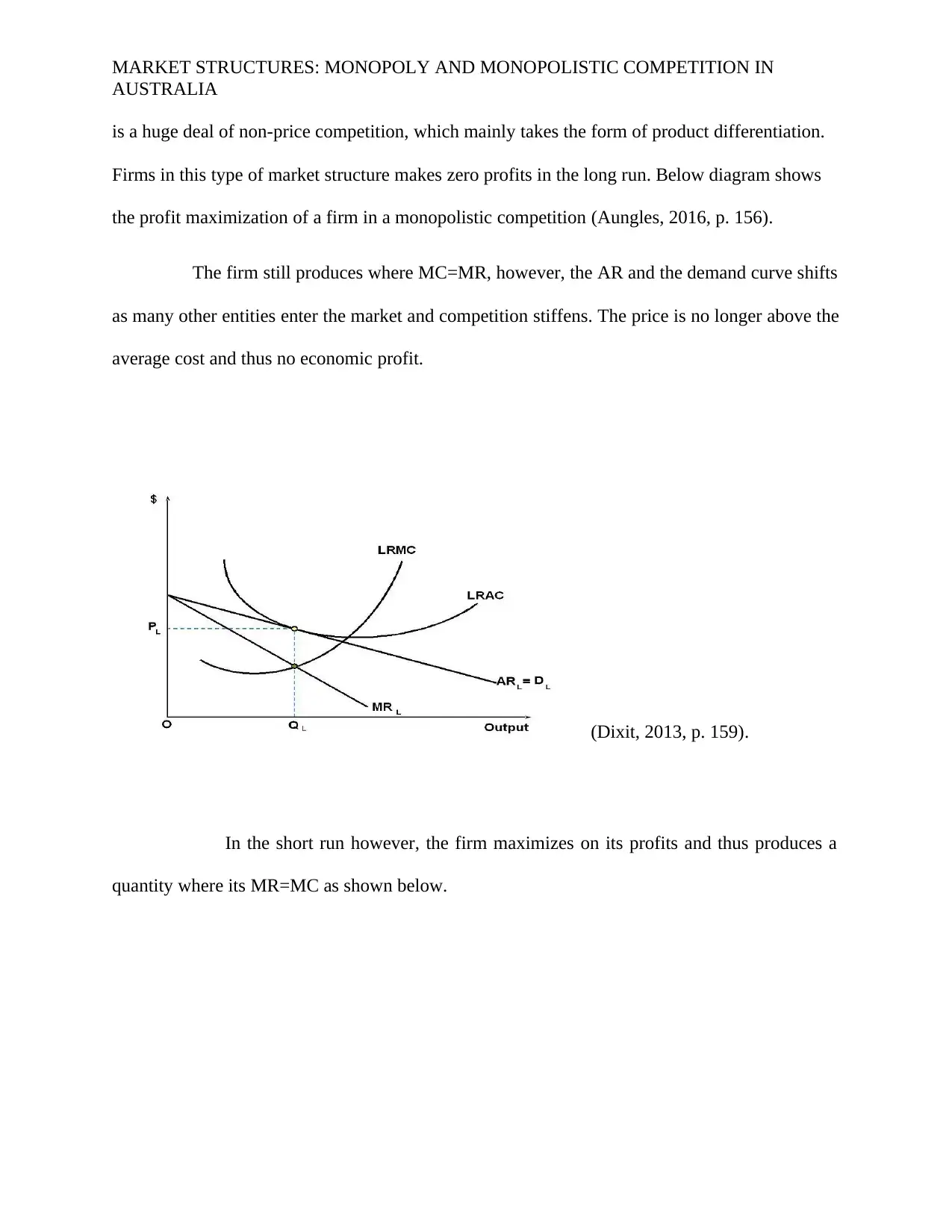
MARKET STRUCTURES: MONOPOLY AND MONOPOLISTIC COMPETITION IN
AUSTRALIA
is a huge deal of non-price competition, which mainly takes the form of product differentiation.
Firms in this type of market structure makes zero profits in the long run. Below diagram shows
the profit maximization of a firm in a monopolistic competition (Aungles, 2016, p. 156).
The firm still produces where MC=MR, however, the AR and the demand curve shifts
as many other entities enter the market and competition stiffens. The price is no longer above the
average cost and thus no economic profit.
(Dixit, 2013, p. 159).
In the short run however, the firm maximizes on its profits and thus produces a
quantity where its MR=MC as shown below.
AUSTRALIA
is a huge deal of non-price competition, which mainly takes the form of product differentiation.
Firms in this type of market structure makes zero profits in the long run. Below diagram shows
the profit maximization of a firm in a monopolistic competition (Aungles, 2016, p. 156).
The firm still produces where MC=MR, however, the AR and the demand curve shifts
as many other entities enter the market and competition stiffens. The price is no longer above the
average cost and thus no economic profit.
(Dixit, 2013, p. 159).
In the short run however, the firm maximizes on its profits and thus produces a
quantity where its MR=MC as shown below.
⊘ This is a preview!⊘
Do you want full access?
Subscribe today to unlock all pages.

Trusted by 1+ million students worldwide
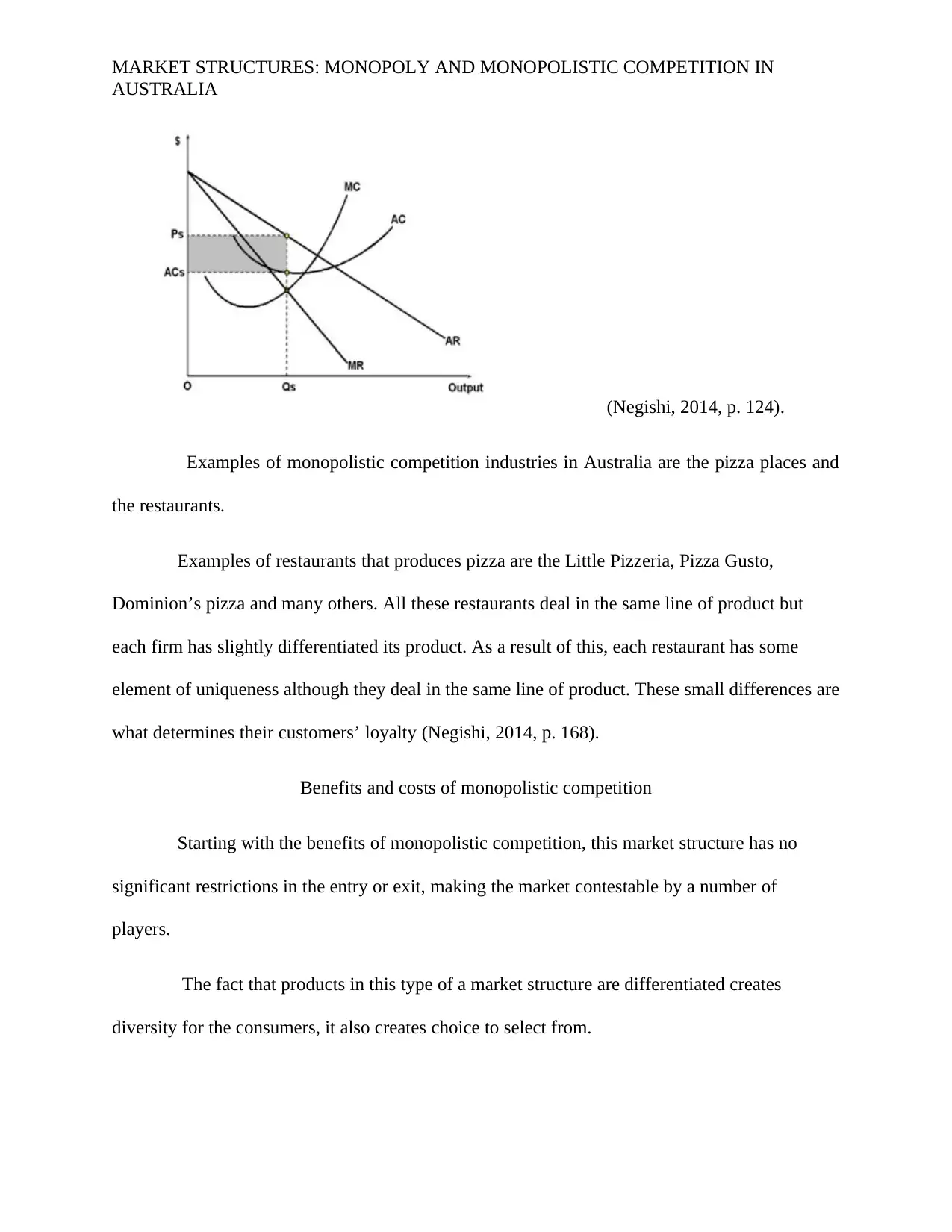
MARKET STRUCTURES: MONOPOLY AND MONOPOLISTIC COMPETITION IN
AUSTRALIA
(Negishi, 2014, p. 124).
Examples of monopolistic competition industries in Australia are the pizza places and
the restaurants.
Examples of restaurants that produces pizza are the Little Pizzeria, Pizza Gusto,
Dominion’s pizza and many others. All these restaurants deal in the same line of product but
each firm has slightly differentiated its product. As a result of this, each restaurant has some
element of uniqueness although they deal in the same line of product. These small differences are
what determines their customers’ loyalty (Negishi, 2014, p. 168).
Benefits and costs of monopolistic competition
Starting with the benefits of monopolistic competition, this market structure has no
significant restrictions in the entry or exit, making the market contestable by a number of
players.
The fact that products in this type of a market structure are differentiated creates
diversity for the consumers, it also creates choice to select from.
AUSTRALIA
(Negishi, 2014, p. 124).
Examples of monopolistic competition industries in Australia are the pizza places and
the restaurants.
Examples of restaurants that produces pizza are the Little Pizzeria, Pizza Gusto,
Dominion’s pizza and many others. All these restaurants deal in the same line of product but
each firm has slightly differentiated its product. As a result of this, each restaurant has some
element of uniqueness although they deal in the same line of product. These small differences are
what determines their customers’ loyalty (Negishi, 2014, p. 168).
Benefits and costs of monopolistic competition
Starting with the benefits of monopolistic competition, this market structure has no
significant restrictions in the entry or exit, making the market contestable by a number of
players.
The fact that products in this type of a market structure are differentiated creates
diversity for the consumers, it also creates choice to select from.
Paraphrase This Document
Need a fresh take? Get an instant paraphrase of this document with our AI Paraphraser
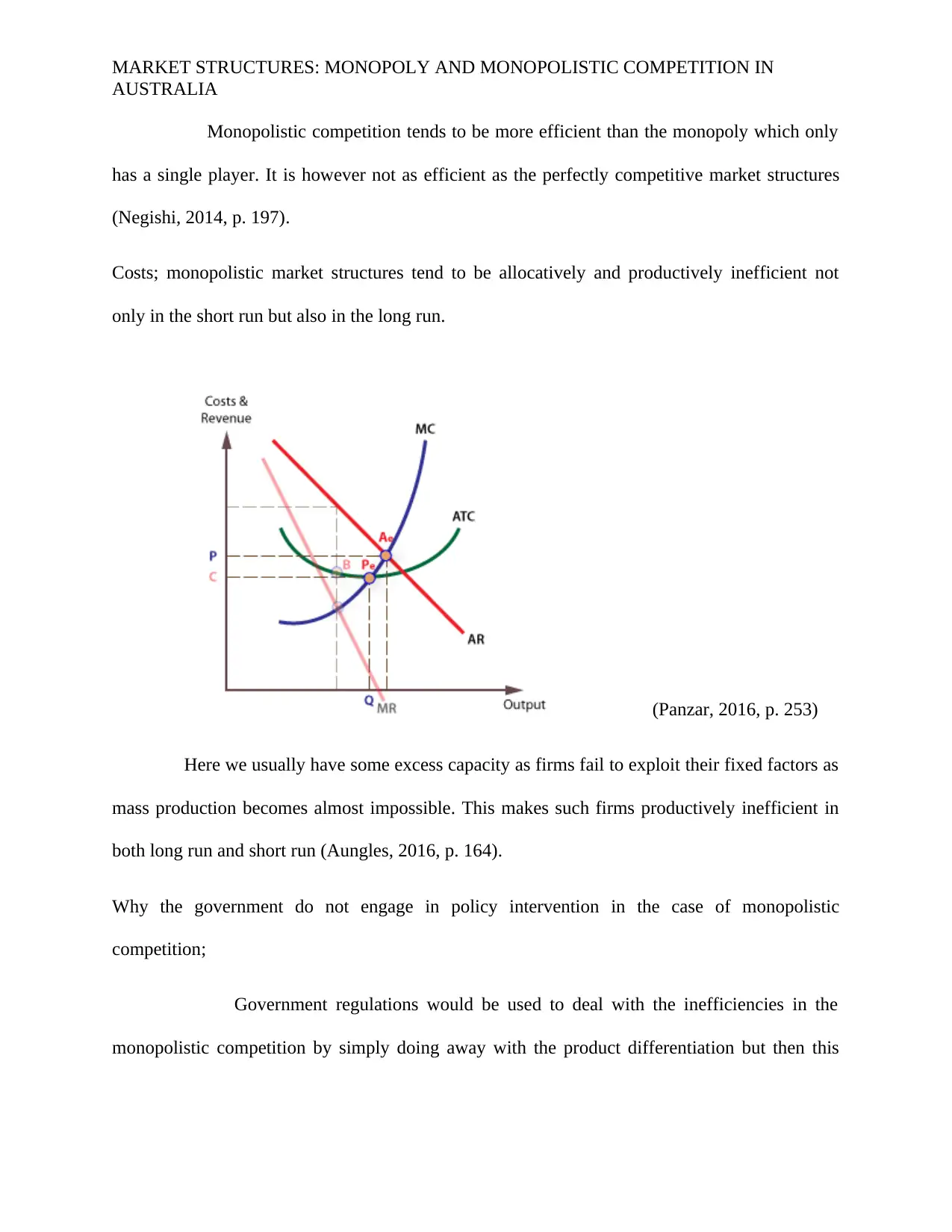
MARKET STRUCTURES: MONOPOLY AND MONOPOLISTIC COMPETITION IN
AUSTRALIA
Monopolistic competition tends to be more efficient than the monopoly which only
has a single player. It is however not as efficient as the perfectly competitive market structures
(Negishi, 2014, p. 197).
Costs; monopolistic market structures tend to be allocatively and productively inefficient not
only in the short run but also in the long run.
(Panzar, 2016, p. 253)
Here we usually have some excess capacity as firms fail to exploit their fixed factors as
mass production becomes almost impossible. This makes such firms productively inefficient in
both long run and short run (Aungles, 2016, p. 164).
Why the government do not engage in policy intervention in the case of monopolistic
competition;
Government regulations would be used to deal with the inefficiencies in the
monopolistic competition by simply doing away with the product differentiation but then this
AUSTRALIA
Monopolistic competition tends to be more efficient than the monopoly which only
has a single player. It is however not as efficient as the perfectly competitive market structures
(Negishi, 2014, p. 197).
Costs; monopolistic market structures tend to be allocatively and productively inefficient not
only in the short run but also in the long run.
(Panzar, 2016, p. 253)
Here we usually have some excess capacity as firms fail to exploit their fixed factors as
mass production becomes almost impossible. This makes such firms productively inefficient in
both long run and short run (Aungles, 2016, p. 164).
Why the government do not engage in policy intervention in the case of monopolistic
competition;
Government regulations would be used to deal with the inefficiencies in the
monopolistic competition by simply doing away with the product differentiation but then this
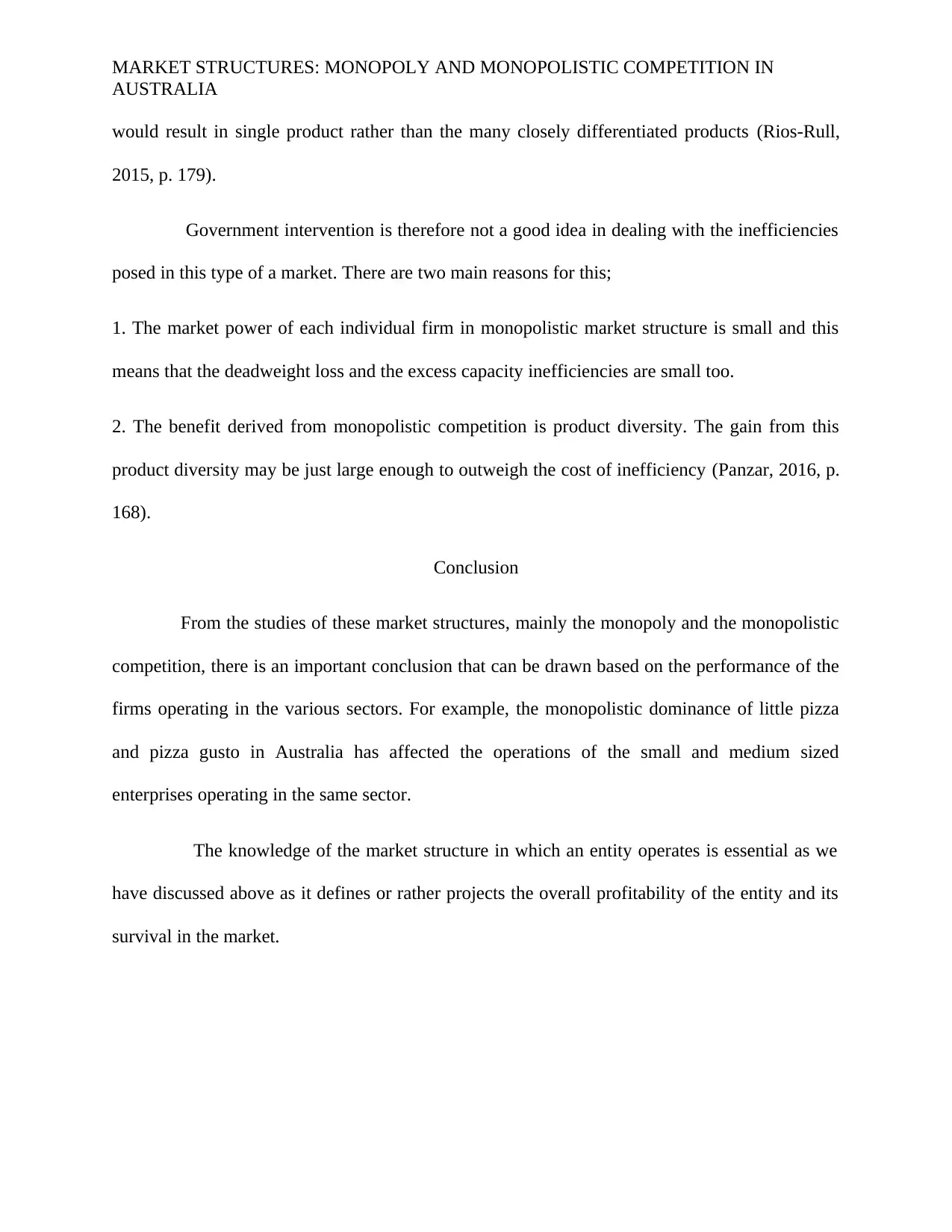
MARKET STRUCTURES: MONOPOLY AND MONOPOLISTIC COMPETITION IN
AUSTRALIA
would result in single product rather than the many closely differentiated products (Rios-Rull,
2015, p. 179).
Government intervention is therefore not a good idea in dealing with the inefficiencies
posed in this type of a market. There are two main reasons for this;
1. The market power of each individual firm in monopolistic market structure is small and this
means that the deadweight loss and the excess capacity inefficiencies are small too.
2. The benefit derived from monopolistic competition is product diversity. The gain from this
product diversity may be just large enough to outweigh the cost of inefficiency (Panzar, 2016, p.
168).
Conclusion
From the studies of these market structures, mainly the monopoly and the monopolistic
competition, there is an important conclusion that can be drawn based on the performance of the
firms operating in the various sectors. For example, the monopolistic dominance of little pizza
and pizza gusto in Australia has affected the operations of the small and medium sized
enterprises operating in the same sector.
The knowledge of the market structure in which an entity operates is essential as we
have discussed above as it defines or rather projects the overall profitability of the entity and its
survival in the market.
AUSTRALIA
would result in single product rather than the many closely differentiated products (Rios-Rull,
2015, p. 179).
Government intervention is therefore not a good idea in dealing with the inefficiencies
posed in this type of a market. There are two main reasons for this;
1. The market power of each individual firm in monopolistic market structure is small and this
means that the deadweight loss and the excess capacity inefficiencies are small too.
2. The benefit derived from monopolistic competition is product diversity. The gain from this
product diversity may be just large enough to outweigh the cost of inefficiency (Panzar, 2016, p.
168).
Conclusion
From the studies of these market structures, mainly the monopoly and the monopolistic
competition, there is an important conclusion that can be drawn based on the performance of the
firms operating in the various sectors. For example, the monopolistic dominance of little pizza
and pizza gusto in Australia has affected the operations of the small and medium sized
enterprises operating in the same sector.
The knowledge of the market structure in which an entity operates is essential as we
have discussed above as it defines or rather projects the overall profitability of the entity and its
survival in the market.
⊘ This is a preview!⊘
Do you want full access?
Subscribe today to unlock all pages.

Trusted by 1+ million students worldwide
1 out of 14
Related Documents
Your All-in-One AI-Powered Toolkit for Academic Success.
+13062052269
info@desklib.com
Available 24*7 on WhatsApp / Email
![[object Object]](/_next/static/media/star-bottom.7253800d.svg)
Unlock your academic potential
Copyright © 2020–2025 A2Z Services. All Rights Reserved. Developed and managed by ZUCOL.





